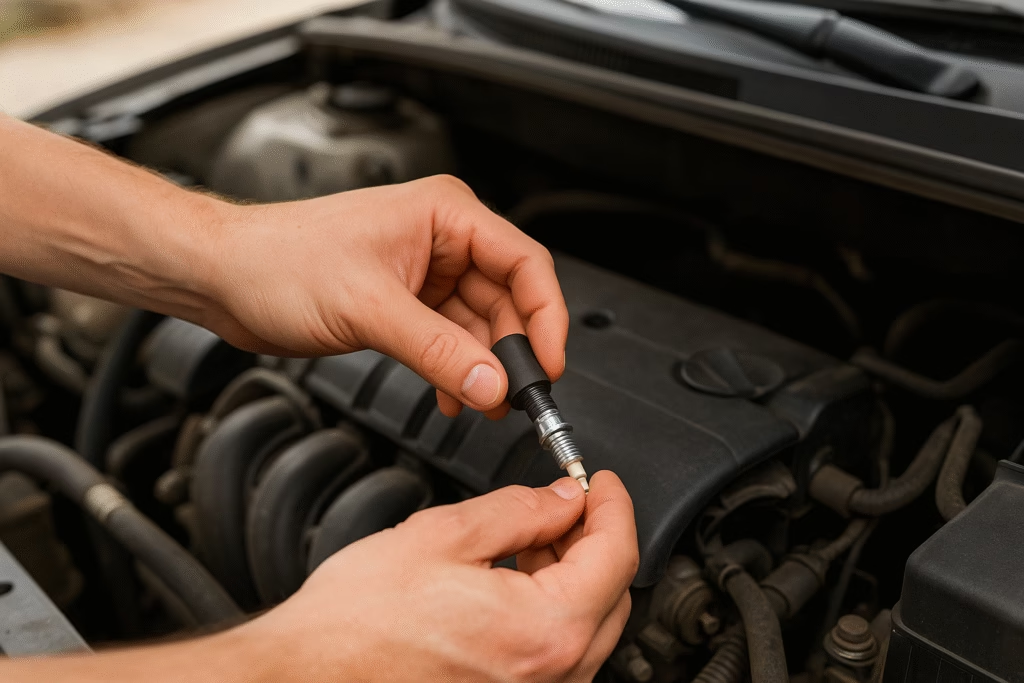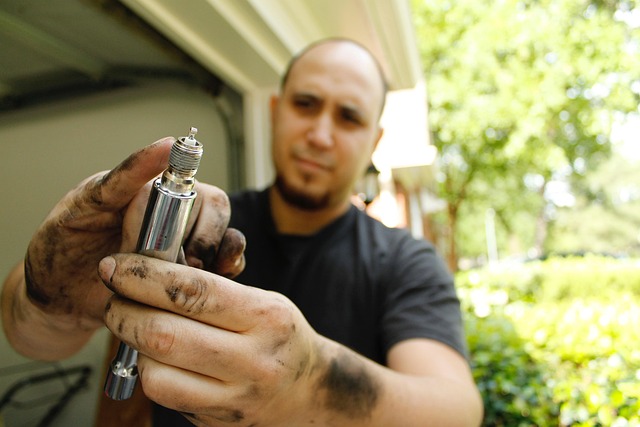How to Change a Car Spark Plug Easily (Step-by-Step Guide)
Table of Contents
- Introduction to How to Change a Car Spark Plug
- Tools and Materials Needed for How to Change a Car Spark Plug
- Step-by-Step Guide on How to Change a Car Spark Plug
- Common Mistakes to Avoid When You Change a Car Spark Plug
- Conclusion on How to Change a Car Spark Plug
- FAQ on How to Change a Car Spark Plug
Introduction to How to Change a Car Spark Plug
Learning how to change a car spark plug is one of the most valuable maintenance skills you can pick up as a car owner. Spark plugs are small but essential components that ignite the air-fuel mixture inside your engine, keeping your vehicle running smoothly. Over time, they wear out and may cause reduced fuel efficiency, rough idling, or even difficulty starting the engine. Fortunately, replacing them is a straightforward process that most people can do at home with just a few basic tools. By handling this task yourself, you save money on mechanic fees and gain a deeper understanding of how your vehicle operates.
Before diving into the actual steps, it’s important to know when a spark plug replacement is needed. Common signs include misfiring, poor acceleration, and increased fuel consumption. Most manufacturers recommend replacement every 30,000 to 100,000 miles depending on the plug type. Always check your owner’s manual for the correct intervals and specifications. In this guide, we’ll cover everything you need: from preparation and safety measures to a complete step-by-step process. By the end, you’ll be confident in performing the job yourself and keeping your engine in top condition.
Tools and Materials Needed for How to Change a Car Spark Plug
Before you begin the process of how to change a car spark plug, gathering the right tools and materials is essential. Having everything ready will save you time and prevent frustration once you start working under the hood. Spark plug replacement requires precision, so the correct tools ensure that you don’t damage the plugs, wires, or engine components. Even though this task is considered a DIY-friendly job, proper preparation makes all the difference in achieving a smooth and successful outcome.
The primary tool you’ll need is a spark plug socket, which is designed with a rubber insert to grip and protect the plug during removal and installation. A ratchet wrench with an extension will help you reach into deeper areas of the engine bay. You’ll also need a torque wrench to tighten the new plugs to manufacturer specifications—overtightening can crack the plug, while under-tightening may lead to poor engine performance. Additionally, a spark plug gap gauge is crucial for ensuring the gap between the electrodes matches your car’s recommended measurements. While many modern plugs come pre-gapped, it’s always wise to double-check before installation.
Aside from tools, make sure you have the correct replacement spark plugs for your vehicle. Check your owner’s manual or consult with a reliable source such as AutoZone or NAPA Auto Parts. Using the wrong type can affect combustion efficiency and shorten engine life. Other useful items include dielectric grease for the ignition boot, anti-seize compound (only if specified by the manufacturer), and a clean cloth for wiping debris around the plug holes. Once you have all these materials, you’ll be fully prepared to move on to the detailed step-by-step guide on how to change a car spark plug with confidence.
Step-by-Step Guide on How to Change a Car Spark Plug
Now that you have the tools and materials ready, let’s walk through the detailed process of how to change a car spark plug. This step-by-step approach ensures that even beginners can follow along and achieve professional-level results. Take your time, work carefully, and remember that safety is always the first priority when performing maintenance on your vehicle. Below, you’ll find the steps broken down into simple, clear instructions.
Step 1: Prepare Your Vehicle
Before doing any work, make sure your car is parked on a flat surface and the engine is completely cool. Working on hot components can lead to burns and damage to the plugs or threads. Disconnect the negative battery terminal to prevent accidental sparks. Open the hood and remove any plastic covers that shield the engine. Locate the spark plug wires or ignition coil packs—these sit directly on top of each spark plug. Taking the time to prepare properly is critical for a smooth job. This initial preparation step sets the stage for the rest of the process of how to change a car spark plug.
Step 2: Remove the Old Spark Plugs
Start by carefully removing one ignition coil or spark plug wire at a time. This prevents mixing up the firing order, which can cause misfires later. Use a spark plug socket attached to your ratchet wrench and extension to loosen the plug by turning it counterclockwise. Be gentle—forcing it can damage the cylinder head threads. Once loosened, pull the plug out slowly, inspecting it for signs of wear, oil deposits, or carbon buildup. These clues can tell you a lot about your engine’s condition. Keep the removed plugs in order so you can match them to their cylinders if you notice irregular wear.
Step 3: Install the New Spark Plugs
Check the gap on your new plugs using a spark plug gap gauge and adjust if necessary to match your vehicle’s specifications. Apply a very light coat of anti-seize (if the manufacturer recommends it) and add dielectric grease to the inside of the ignition boot. Insert the new spark plug into the socket and gently thread it by hand to avoid cross-threading. Once it’s seated, tighten it with a torque wrench to the specified torque listed in your owner’s manual. Reattach the ignition coil or spark plug wire, ensuring a snug fit. Repeat this process for each plug, working one at a time until all plugs have been replaced.
Step 4: Test Your Work
After all spark plugs are replaced, reconnect the battery terminal and start the engine. It should run smoothly without hesitation or misfiring. Take a short test drive to confirm improved performance, better acceleration, and smoother idling. If the car struggles to start or runs rough, double-check the connections and torque. Properly following the steps on how to change a car spark plug not only ensures your vehicle runs better but also extends the lifespan of your engine. Congratulations—you’ve just completed a crucial maintenance task that will save you money and boost your car’s efficiency.

Common Mistakes to Avoid When You Change a Car Spark Plug
Even though learning how to change a car spark plug is straightforward, there are a few common mistakes that can lead to costly repairs or poor performance if overlooked. Avoiding these errors will not only save you time but also protect the integrity of your engine. Whether you’re a first-time DIYer or someone with a bit of mechanical experience, being aware of these pitfalls ensures a smoother process and longer-lasting results.
One frequent mistake is failing to check the spark plug gap. Even if new plugs claim to be pre-gapped, small discrepancies can affect combustion efficiency. Always use a gap gauge to confirm the correct measurement. Another issue is cross-threading during installation. If a plug is forced into the cylinder head at the wrong angle, it can damage the threads, requiring expensive repairs. To prevent this, always thread the plug by hand before tightening with a wrench. Many beginners also forget to use a torque wrench, leading to plugs that are either too tight or too loose—both situations compromise engine health.
Additionally, replacing all the plugs at once without keeping track of the firing order is a common error. Mixing up ignition coils or spark plug wires causes misfires and rough idling. Work on one plug at a time to avoid confusion. Some people also skip cleaning around the plug holes before removal, which can allow dirt or debris to fall into the combustion chamber, risking internal damage. Applying excessive anti-seize compound is another mistake; it can cause inaccurate torque readings and plug loosening. Always follow the manufacturer’s guidelines on whether anti-seize is necessary.
Finally, ignoring the signs of engine trouble after installation is risky. If your vehicle still misfires or idles poorly, don’t assume everything is fine. Double-check your installation steps and, if needed, consult resources like Wikipedia’s spark plug overview or a trusted mechanic. By paying attention to these details, you’ll avoid the most common mistakes and master the process of how to change a car spark plug with confidence.
Conclusion on How to Change a Car Spark Plug
By now, you’ve learned the complete process of how to change a car spark plug, from preparation and tool selection to the final test drive. This maintenance task, while often overlooked, plays a major role in your car’s overall health and efficiency. Spark plugs directly influence how smoothly your engine starts, accelerates, and consumes fuel. Neglecting them can lead to performance issues, higher fuel costs, and unnecessary wear on other engine parts. On the other hand, changing them on time restores engine performance, improves fuel economy, and can even reduce harmful emissions.
One of the greatest benefits of learning how to change a car spark plug yourself is the savings it brings. Instead of paying a mechanic labor fees, you only invest in the cost of plugs and basic tools—many of which you can use for other DIY car projects. The satisfaction of successfully completing this task builds confidence for tackling more complex car maintenance jobs in the future. For new drivers and seasoned owners alike, this is a foundational skill worth mastering. Plus, it helps you build a stronger connection with your vehicle, understanding its needs and performance better than ever before.
Another important takeaway is safety and attention to detail. Using the right torque, handling wires carefully, and keeping the engine clean all ensure long-term reliability. If you’re ever unsure, consulting your vehicle’s manual or reliable automotive resources like Carfax maintenance guides will give you extra reassurance. Remember: every vehicle has unique requirements, but the general steps remain consistent. Taking the time to do it properly will reward you with years of smooth driving.
Ultimately, mastering how to change a car spark plug is about more than saving money—it’s about empowering yourself as a car owner. With regular maintenance, careful attention, and the confidence you’ve built from this guide, you’ll keep your vehicle running at its best. Next time you notice sluggish performance or increased fuel consumption, you’ll know exactly what to check and how to fix it. That’s the power of knowledge and hands-on care.
FAQ on How to Change a Car Spark Plug
Below are some of the most common questions people ask about how to change a car spark plug. These answers will help clear up any confusion and provide additional confidence before you begin the process yourself.
How often should I change my car’s spark plugs?
The replacement interval depends on the type of plugs and your vehicle model. Standard copper plugs may last around 30,000 miles, while platinum or iridium plugs can last up to 100,000 miles. Always consult your owner’s manual for the manufacturer’s recommendations when planning how to change a car spark plug.
What are the signs that my spark plugs need replacing?
Common symptoms include rough idling, poor fuel economy, sluggish acceleration, engine misfires, and difficulty starting. If you experience these issues, it’s a strong indicator that you need to learn how to change a car spark plug sooner rather than later.
Can I change just one spark plug, or should I replace them all?
It’s always best to replace all spark plugs at the same time. Even if only one is failing, the others are likely close behind. Doing them together ensures balanced engine performance and prevents repeat labor. This is a key principle when understanding how to change a car spark plug properly.
What tools do I absolutely need for the job?
The essentials include a spark plug socket, a ratchet with an extension, and a torque wrench. A gap gauge is also important to confirm electrode spacing. These tools are the foundation of learning how to change a car spark plug correctly and safely.
Is it dangerous to change spark plugs myself?
No, as long as you follow safety precautions such as letting the engine cool, disconnecting the battery, and handling tools carefully. Spark plug replacement is considered one of the safest and most beginner-friendly maintenance tasks when learning how to change a car spark plug.
Where can I learn more about spark plug maintenance?
You can find reliable resources at Consumer Reports and automotive education platforms. These provide detailed information to support your learning journey on how to change a car spark plug.
Read Similar Topics

Share this:
- Click to share on Facebook (Opens in new window) Facebook
- Click to share on X (Opens in new window) X
- Click to share on LinkedIn (Opens in new window) LinkedIn
- Click to share on Reddit (Opens in new window) Reddit
- Click to share on X (Opens in new window) X
- Click to share on Threads (Opens in new window) Threads
- Click to share on WhatsApp (Opens in new window) WhatsApp




